
Rockport is a town in Knox County, Maine, United States. It is 35 miles southeast of Augusta. The population was 3,644 at the 2020 census. Rockport is a popular tourist destination and art colony.

Camden is a town in Knox County, Maine, United States. The population was 5,232 at the 2020 census. The population of the town more than triples during the summer months, due to tourists and summer residents. Camden is a summer colony in the Mid-Coast region of Maine. Similar to Bar Harbor, Nantucket and North Haven, Camden is well known for its summer community of wealthy Northeasterners, mostly from Boston, New York City, and Philadelphia.

The Spencer–Peirce–Little Farm is a Colonial American farm located at 5 Little's Lane, Newbury, Massachusetts, United States, in the midst of 231 acres (93 ha) of open land bordering the Merrimack River and Plum Island Sound. The farmhouse, dating to c. 1690, was designated a National Historic Landmark in 1968 as an extremely rare 17th-century stone house in New England. It is now a nonprofit museum owned and operated by Historic New England and open to the public several days a week during the warmer months; an admission fee is charged for non Members.

The Historic Haile Homestead, also known as Haile Plantation House or Kanapaha, is a historic site and museum in Gainesville, Florida, United States. It is located at 8500 SW Archer Rd. SR 24. On May 2, 1986, the plantation house was added to the U.S. National Register of Historic Places.The Homestead is unique in the Nation for its "Talking Walls." For a reason lost to time the Haile family and friends wrote over 12,500 words on the walls, dating back to the 1850s.

The Gen. Horatio Gates House and Golden Plough Tavern are two connecting historic buildings which are located in downtown York, York County, Pennsylvania. The buildings were restored between July 1961 and June 1964, and operated as a museum by the York County History Center.

Mill Grove is a historic house and estate on Pawlings Road in Audubon, Pennsylvania. Built in the 1760s, it is notable as the first home in America of painter and naturalist John James Audubon (1785-1851), for whom the community is named. The 130-acre (53 ha) estate is now maintained as a museum and wildlife sanctuary by Montgomery County, and was designated a National Historic Landmark in 1989. The house serves as the educational center of the Pennsylvania chapter of the National Audubon Society, and is known as John James Audubon Center at Mill Grove.

Oxon Cove Park and Oxon Cove Farm is a national historic district that includes a living farm museum operated by the National Park Service, and located at Oxon Hill, Prince George's County, Maryland. It is part of National Capital Parks-East. It was listed on the National Register of Historic Places in 2003.

Lewis R. French is a gaff-rigged topsail schooner sailing out of Camden, Maine as a "Maine windjammer" offering 3 to 6 night cruises to tourists. Built in 1871, she is the oldest known two-masted schooner in the United States, and one of a small number of this once-common form of vessel in active service. The ship was designated a US National Historic Landmark in 1992.
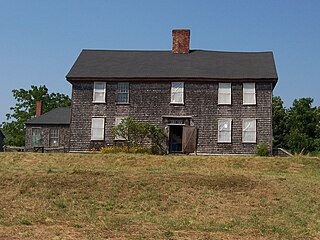
The Stanton–Davis Homestead Museum is a historic house on Greenhaven Road in Stonington, Connecticut. It was built around 1700. The property has been a working farm for over 350 years, most by members of the Davis family. The property is currently in the process of being restored by the Stanton-Davis Society into a museum.
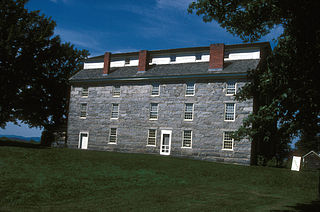
The Brownington Village Historic District is a historic site in Brownington, Vermont, United States. It is located near the intersection of Hinman and Brownington Center roads. It was added to the U.S. National Register of Historic Places on June 9, 1973. The district consists of five buildings within the Old Stone House Museum complex and three neighboring houses, dating from the early 19th century.

The Joseph Dewey House is a historic house museum at 87 South Maple Street in Westfield, Massachusetts. Built about 1735, it is one of the city's few surviving pre-Revolutionary buildings. It is now maintained as a museum property by the local historical society. The property was listed on the National Register of Historic Places in 2001.

Rose Hill Manor, now known as Rose Hill Manor Park & Children's Museum, is a historic home located at Frederick, Frederick County, Maryland. It is a 2+1⁄2-story brick house. A notable feature is the large two-story pedimented portico supported by fluted Doric columns on the first floor and Ionic columns on the balustraded second floor. It was the retirement home of Thomas Johnson (1732–1819), the first elected governor of the State of Maryland and Associate Justice of the United States Supreme Court. It was built in the mid-1790s by his daughter and son-in-law.
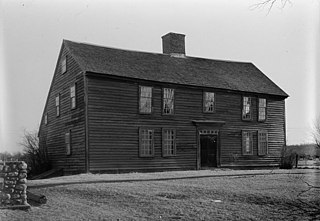
The Thomas Lee House is a historic house at the junction of Giant's Neck Road and Connecticut Route 156 in the Niantic section of East Lyme, Connecticut, United States. Built about 1660, it is one of the oldest wood-frame houses in Connecticut. Restored in the early 20th century by Norman Isham, it is now maintained by the East Lyme Historical Society as a museum. It was listed on the National Register of Historic Places in 1970.

The Potter Place Railroad Station is a historic railroad station on Depot Street in Andover, New Hampshire. Built in 1874, it is one of the best-preserved surviving 19th-century railroad stations in Merrimack County. It now houses the museum of the Andover Historical Society. It was listed on the National Register of Historic Places in 1989.

The United States lightship Barnegat (LV-79/WAL-506), is located in Camden, Camden County, New Jersey, United States. The lightship was built in 1904 and was added to the National Register of Historic Places on 29 November 1979.

Knaut–Rhuland House is a historic 18th-century house in Lunenburg, Nova Scotia, Canada. It is a designated a National Historic Site of Canada, as well as a Provincially Registered Property under the provincial Heritage Property Act. It is located within the Old Town Lunenburg World Heritage Site. The Knaut–Rhuland House is owned by the Lunenburg Heritage Society, which operates a museum in the house open to the public during the summer.
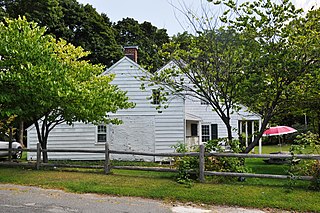
The Hammond House is located on Grasslands Road in the Eastview section of the town of Mount Pleasant, New York, United States. It is a wooden building whose oldest part dates to the 1720s, with latter additions during the 19th century. In 1980 it was added to the National Register of Historic Places.

Bloomsbury Farm was an 18th-century timbered framed house, one of the oldest privately owned residences in Spotsylvania County, Virginia. The house was originally built by the Robinson family sometime between 1785 and 1790. It was architecturally significant for its eighteenth-century construction methods and decorative elements. The surrounding location is also significant as the site of the last engagement between Confederate and Union forces in the Battle of Spotsylvania Courthouse on May 19, 1864. Bloomsbury Farm was added to the National Register of Historic Places in May 2000. The house was demolished in December 2014 by Leonard Atkins, a nearby resident who purchased the property in November 2014 ostensibly to restore it. Atkins cited the building's supposedly poor condition and public safety as the reasons for the abrupt demolition, and he planned to replace the historic house with a new one commensurate in style and value with the modern houses in the surrounding development in which he lives. The farm was removed from the National Register in 2017.

The William K. Eastman House, also known as the Eastman-Lord House, is a historic house museum at 100 Main Street in Conway, New Hampshire. Built in 1818, it was the home of William K. Eastman, a prominent local businessman, politician, and civic leader until his death in 1879. Now home to the Conway Historical Society, it was listed on the National Register of Historic Places in 2001.
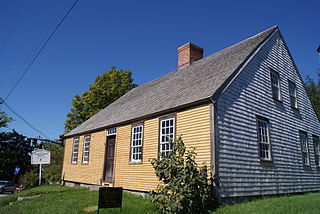
The Chapman-Hall House is a historic house museum at 270 Main Street in Damariscotta, Maine. Built in 1754 by one of the area's first permanent white settlers, it is the oldest standing house in the town, and one of the oldest in the state. It was listed on the National Register of Historic Places in 1970.






















